Business Decision Making: Evaluating Projects with NPV and PBP
VerifiedAdded on 2023/06/05
|8
|1438
|359
Report
AI Summary
This report evaluates two potential projects, A and B, using Net Present Value (NPV) and Payback Period (PBP) techniques to determine the most financially viable option for S&P plc, a bag manufacturing company. The analysis includes calculations of NPV and PBP for both projects, a comparison of the two evaluation methods, and a discussion of financial and non-financial factors influencing investment decisions. The report concludes that NPV is the more reliable method and recommends Project A (synthetic leather bags) due to its higher NPV. It also highlights the importance of considering both financial factors like cash flow and profitability, and non-financial factors like legal compliance, employee morale, and competitive landscape when making investment decisions.

Business Decision
Making
Making
Paraphrase This Document
Need a fresh take? Get an instant paraphrase of this document with our AI Paraphraser

Table of Contents
INTRODUCTION ..........................................................................................................................3
MAIN BODY ..................................................................................................................................3
Calculation of Net Present Value (NPV) of both the projects....................................................3
Calculation of Payback Period of projects A and B....................................................................4
Analysis and evaluating the both the techniques in project A and project B..............................5
Financial and non-financial components while making investment decision.............................5
CONCLUSION ...............................................................................................................................6
REFERENCES................................................................................................................................8
INTRODUCTION ..........................................................................................................................3
MAIN BODY ..................................................................................................................................3
Calculation of Net Present Value (NPV) of both the projects....................................................3
Calculation of Payback Period of projects A and B....................................................................4
Analysis and evaluating the both the techniques in project A and project B..............................5
Financial and non-financial components while making investment decision.............................5
CONCLUSION ...............................................................................................................................6
REFERENCES................................................................................................................................8
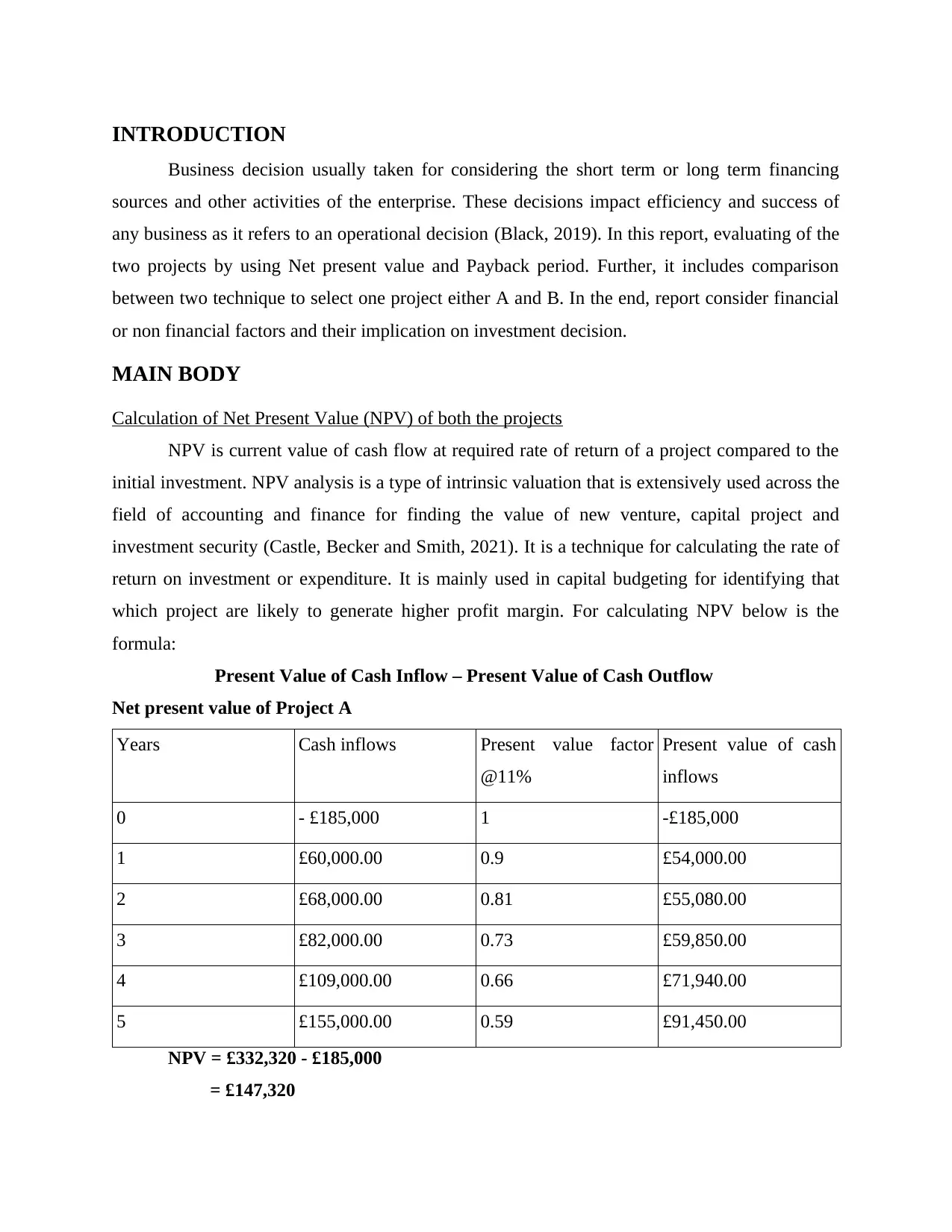
INTRODUCTION
Business decision usually taken for considering the short term or long term financing
sources and other activities of the enterprise. These decisions impact efficiency and success of
any business as it refers to an operational decision (Black, 2019). In this report, evaluating of the
two projects by using Net present value and Payback period. Further, it includes comparison
between two technique to select one project either A and B. In the end, report consider financial
or non financial factors and their implication on investment decision.
MAIN BODY
Calculation of Net Present Value (NPV) of both the projects
NPV is current value of cash flow at required rate of return of a project compared to the
initial investment. NPV analysis is a type of intrinsic valuation that is extensively used across the
field of accounting and finance for finding the value of new venture, capital project and
investment security (Castle, Becker and Smith, 2021). It is a technique for calculating the rate of
return on investment or expenditure. It is mainly used in capital budgeting for identifying that
which project are likely to generate higher profit margin. For calculating NPV below is the
formula:
Present Value of Cash Inflow – Present Value of Cash Outflow
Net present value of Project A
Years Cash inflows Present value factor
@11%
Present value of cash
inflows
0 - £185,000 1 -£185,000
1 £60,000.00 0.9 £54,000.00
2 £68,000.00 0.81 £55,080.00
3 £82,000.00 0.73 £59,850.00
4 £109,000.00 0.66 £71,940.00
5 £155,000.00 0.59 £91,450.00
NPV = £332,320 - £185,000
= £147,320
Business decision usually taken for considering the short term or long term financing
sources and other activities of the enterprise. These decisions impact efficiency and success of
any business as it refers to an operational decision (Black, 2019). In this report, evaluating of the
two projects by using Net present value and Payback period. Further, it includes comparison
between two technique to select one project either A and B. In the end, report consider financial
or non financial factors and their implication on investment decision.
MAIN BODY
Calculation of Net Present Value (NPV) of both the projects
NPV is current value of cash flow at required rate of return of a project compared to the
initial investment. NPV analysis is a type of intrinsic valuation that is extensively used across the
field of accounting and finance for finding the value of new venture, capital project and
investment security (Castle, Becker and Smith, 2021). It is a technique for calculating the rate of
return on investment or expenditure. It is mainly used in capital budgeting for identifying that
which project are likely to generate higher profit margin. For calculating NPV below is the
formula:
Present Value of Cash Inflow – Present Value of Cash Outflow
Net present value of Project A
Years Cash inflows Present value factor
@11%
Present value of cash
inflows
0 - £185,000 1 -£185,000
1 £60,000.00 0.9 £54,000.00
2 £68,000.00 0.81 £55,080.00
3 £82,000.00 0.73 £59,850.00
4 £109,000.00 0.66 £71,940.00
5 £155,000.00 0.59 £91,450.00
NPV = £332,320 - £185,000
= £147,320
⊘ This is a preview!⊘
Do you want full access?
Subscribe today to unlock all pages.

Trusted by 1+ million students worldwide
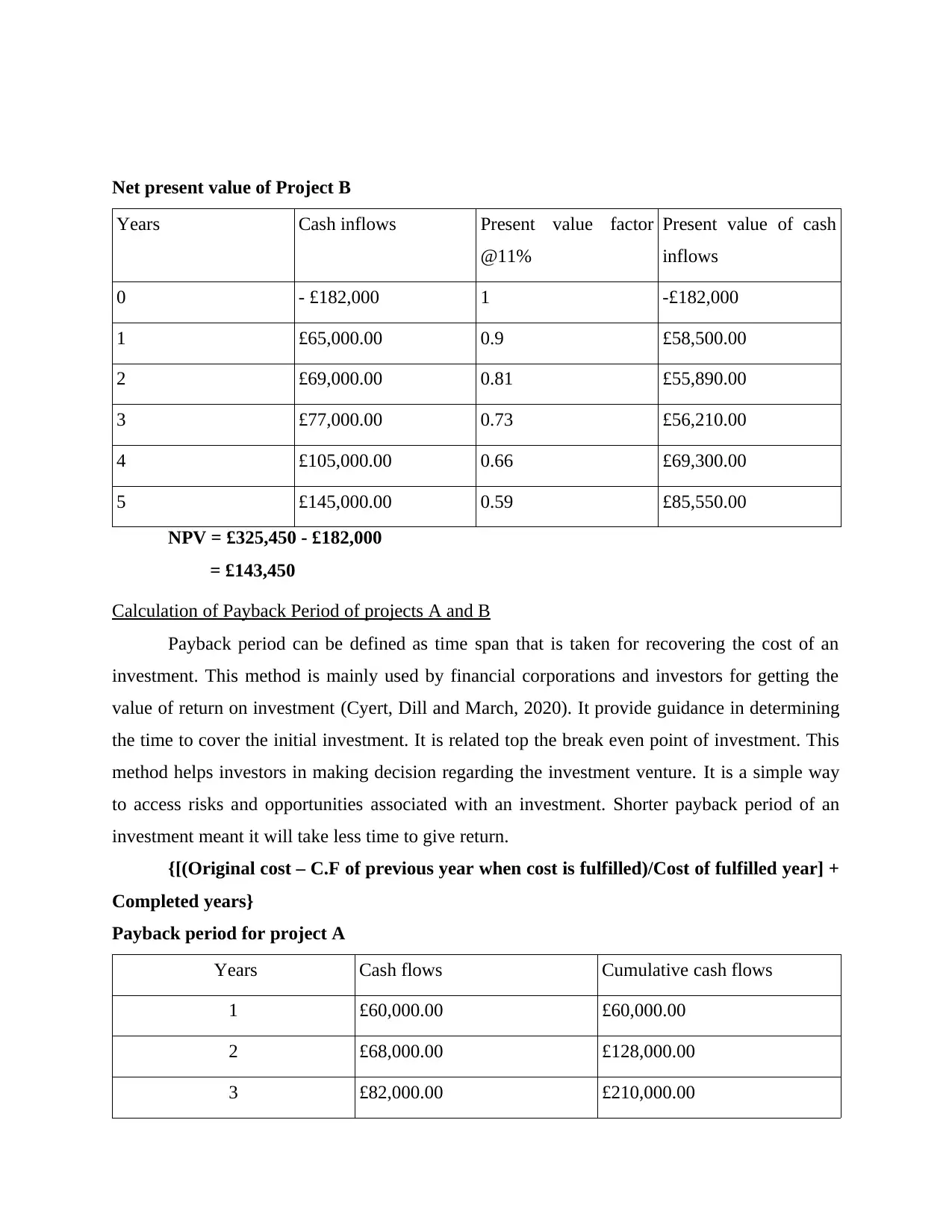
Net present value of Project B
Years Cash inflows Present value factor
@11%
Present value of cash
inflows
0 - £182,000 1 -£182,000
1 £65,000.00 0.9 £58,500.00
2 £69,000.00 0.81 £55,890.00
3 £77,000.00 0.73 £56,210.00
4 £105,000.00 0.66 £69,300.00
5 £145,000.00 0.59 £85,550.00
NPV = £325,450 - £182,000
= £143,450
Calculation of Payback Period of projects A and B
Payback period can be defined as time span that is taken for recovering the cost of an
investment. This method is mainly used by financial corporations and investors for getting the
value of return on investment (Cyert, Dill and March, 2020). It provide guidance in determining
the time to cover the initial investment. It is related top the break even point of investment. This
method helps investors in making decision regarding the investment venture. It is a simple way
to access risks and opportunities associated with an investment. Shorter payback period of an
investment meant it will take less time to give return.
{[(Original cost – C.F of previous year when cost is fulfilled)/Cost of fulfilled year] +
Completed years}
Payback period for project A
Years Cash flows Cumulative cash flows
1 £60,000.00 £60,000.00
2 £68,000.00 £128,000.00
3 £82,000.00 £210,000.00
Years Cash inflows Present value factor
@11%
Present value of cash
inflows
0 - £182,000 1 -£182,000
1 £65,000.00 0.9 £58,500.00
2 £69,000.00 0.81 £55,890.00
3 £77,000.00 0.73 £56,210.00
4 £105,000.00 0.66 £69,300.00
5 £145,000.00 0.59 £85,550.00
NPV = £325,450 - £182,000
= £143,450
Calculation of Payback Period of projects A and B
Payback period can be defined as time span that is taken for recovering the cost of an
investment. This method is mainly used by financial corporations and investors for getting the
value of return on investment (Cyert, Dill and March, 2020). It provide guidance in determining
the time to cover the initial investment. It is related top the break even point of investment. This
method helps investors in making decision regarding the investment venture. It is a simple way
to access risks and opportunities associated with an investment. Shorter payback period of an
investment meant it will take less time to give return.
{[(Original cost – C.F of previous year when cost is fulfilled)/Cost of fulfilled year] +
Completed years}
Payback period for project A
Years Cash flows Cumulative cash flows
1 £60,000.00 £60,000.00
2 £68,000.00 £128,000.00
3 £82,000.00 £210,000.00
Paraphrase This Document
Need a fresh take? Get an instant paraphrase of this document with our AI Paraphraser
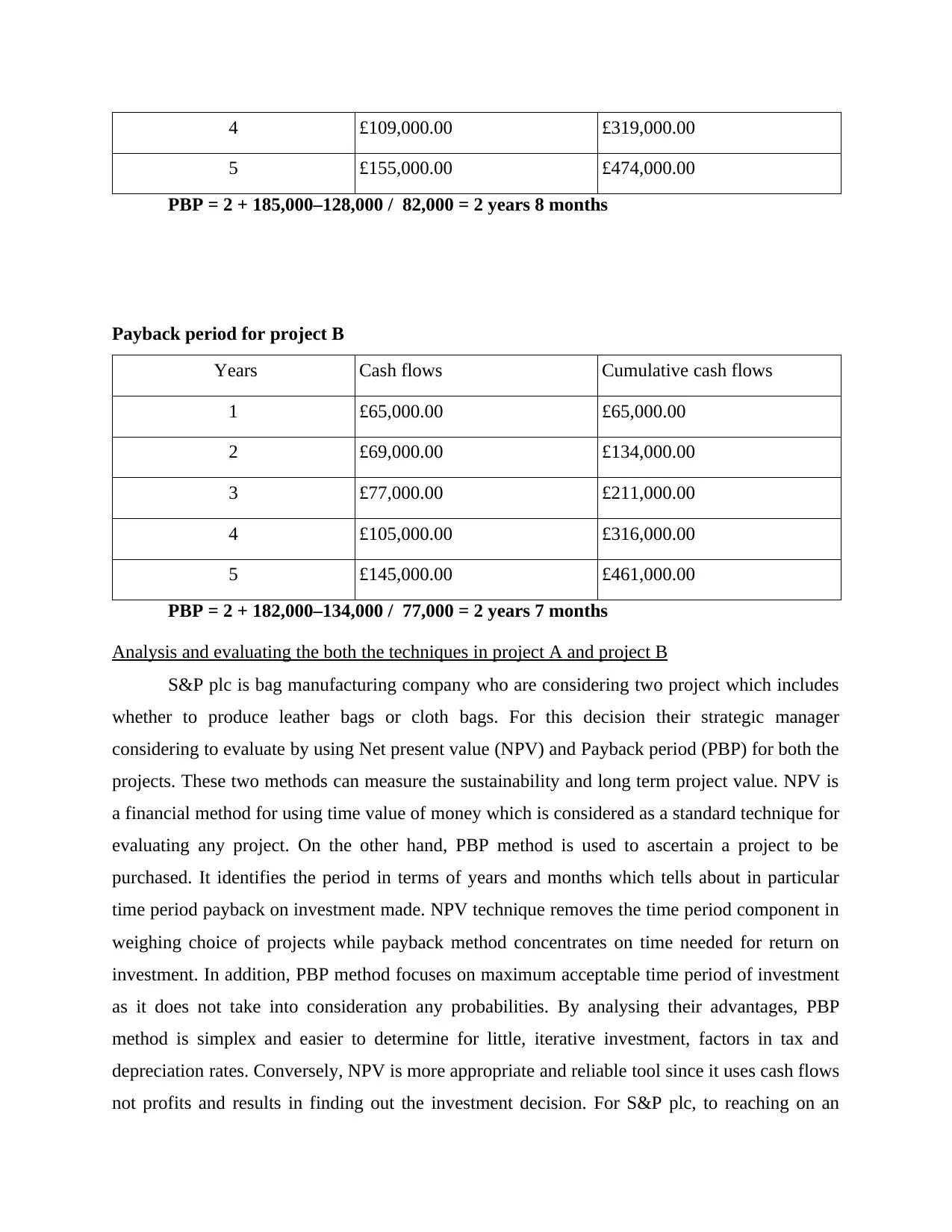
4 £109,000.00 £319,000.00
5 £155,000.00 £474,000.00
PBP = 2 + 185,000–128,000 / 82,000 = 2 years 8 months
Payback period for project B
Years Cash flows Cumulative cash flows
1 £65,000.00 £65,000.00
2 £69,000.00 £134,000.00
3 £77,000.00 £211,000.00
4 £105,000.00 £316,000.00
5 £145,000.00 £461,000.00
PBP = 2 + 182,000–134,000 / 77,000 = 2 years 7 months
Analysis and evaluating the both the techniques in project A and project B
S&P plc is bag manufacturing company who are considering two project which includes
whether to produce leather bags or cloth bags. For this decision their strategic manager
considering to evaluate by using Net present value (NPV) and Payback period (PBP) for both the
projects. These two methods can measure the sustainability and long term project value. NPV is
a financial method for using time value of money which is considered as a standard technique for
evaluating any project. On the other hand, PBP method is used to ascertain a project to be
purchased. It identifies the period in terms of years and months which tells about in particular
time period payback on investment made. NPV technique removes the time period component in
weighing choice of projects while payback method concentrates on time needed for return on
investment. In addition, PBP method focuses on maximum acceptable time period of investment
as it does not take into consideration any probabilities. By analysing their advantages, PBP
method is simplex and easier to determine for little, iterative investment, factors in tax and
depreciation rates. Conversely, NPV is more appropriate and reliable tool since it uses cash flows
not profits and results in finding out the investment decision. For S&P plc, to reaching on an
5 £155,000.00 £474,000.00
PBP = 2 + 185,000–128,000 / 82,000 = 2 years 8 months
Payback period for project B
Years Cash flows Cumulative cash flows
1 £65,000.00 £65,000.00
2 £69,000.00 £134,000.00
3 £77,000.00 £211,000.00
4 £105,000.00 £316,000.00
5 £145,000.00 £461,000.00
PBP = 2 + 182,000–134,000 / 77,000 = 2 years 7 months
Analysis and evaluating the both the techniques in project A and project B
S&P plc is bag manufacturing company who are considering two project which includes
whether to produce leather bags or cloth bags. For this decision their strategic manager
considering to evaluate by using Net present value (NPV) and Payback period (PBP) for both the
projects. These two methods can measure the sustainability and long term project value. NPV is
a financial method for using time value of money which is considered as a standard technique for
evaluating any project. On the other hand, PBP method is used to ascertain a project to be
purchased. It identifies the period in terms of years and months which tells about in particular
time period payback on investment made. NPV technique removes the time period component in
weighing choice of projects while payback method concentrates on time needed for return on
investment. In addition, PBP method focuses on maximum acceptable time period of investment
as it does not take into consideration any probabilities. By analysing their advantages, PBP
method is simplex and easier to determine for little, iterative investment, factors in tax and
depreciation rates. Conversely, NPV is more appropriate and reliable tool since it uses cash flows
not profits and results in finding out the investment decision. For S&P plc, to reaching on an
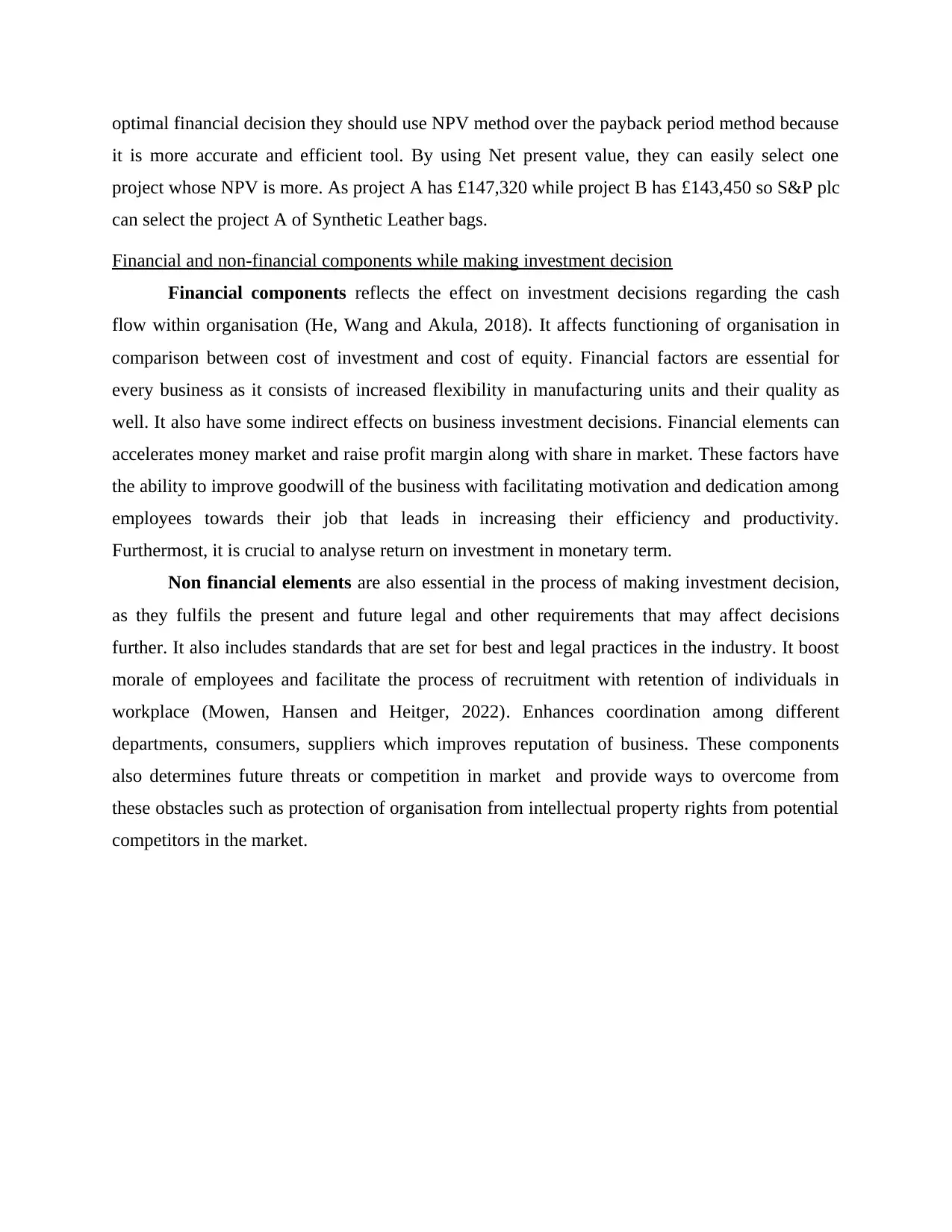
optimal financial decision they should use NPV method over the payback period method because
it is more accurate and efficient tool. By using Net present value, they can easily select one
project whose NPV is more. As project A has £147,320 while project B has £143,450 so S&P plc
can select the project A of Synthetic Leather bags.
Financial and non-financial components while making investment decision
Financial components reflects the effect on investment decisions regarding the cash
flow within organisation (He, Wang and Akula, 2018). It affects functioning of organisation in
comparison between cost of investment and cost of equity. Financial factors are essential for
every business as it consists of increased flexibility in manufacturing units and their quality as
well. It also have some indirect effects on business investment decisions. Financial elements can
accelerates money market and raise profit margin along with share in market. These factors have
the ability to improve goodwill of the business with facilitating motivation and dedication among
employees towards their job that leads in increasing their efficiency and productivity.
Furthermost, it is crucial to analyse return on investment in monetary term.
Non financial elements are also essential in the process of making investment decision,
as they fulfils the present and future legal and other requirements that may affect decisions
further. It also includes standards that are set for best and legal practices in the industry. It boost
morale of employees and facilitate the process of recruitment with retention of individuals in
workplace (Mowen, Hansen and Heitger, 2022). Enhances coordination among different
departments, consumers, suppliers which improves reputation of business. These components
also determines future threats or competition in market and provide ways to overcome from
these obstacles such as protection of organisation from intellectual property rights from potential
competitors in the market.
it is more accurate and efficient tool. By using Net present value, they can easily select one
project whose NPV is more. As project A has £147,320 while project B has £143,450 so S&P plc
can select the project A of Synthetic Leather bags.
Financial and non-financial components while making investment decision
Financial components reflects the effect on investment decisions regarding the cash
flow within organisation (He, Wang and Akula, 2018). It affects functioning of organisation in
comparison between cost of investment and cost of equity. Financial factors are essential for
every business as it consists of increased flexibility in manufacturing units and their quality as
well. It also have some indirect effects on business investment decisions. Financial elements can
accelerates money market and raise profit margin along with share in market. These factors have
the ability to improve goodwill of the business with facilitating motivation and dedication among
employees towards their job that leads in increasing their efficiency and productivity.
Furthermost, it is crucial to analyse return on investment in monetary term.
Non financial elements are also essential in the process of making investment decision,
as they fulfils the present and future legal and other requirements that may affect decisions
further. It also includes standards that are set for best and legal practices in the industry. It boost
morale of employees and facilitate the process of recruitment with retention of individuals in
workplace (Mowen, Hansen and Heitger, 2022). Enhances coordination among different
departments, consumers, suppliers which improves reputation of business. These components
also determines future threats or competition in market and provide ways to overcome from
these obstacles such as protection of organisation from intellectual property rights from potential
competitors in the market.
⊘ This is a preview!⊘
Do you want full access?
Subscribe today to unlock all pages.

Trusted by 1+ million students worldwide
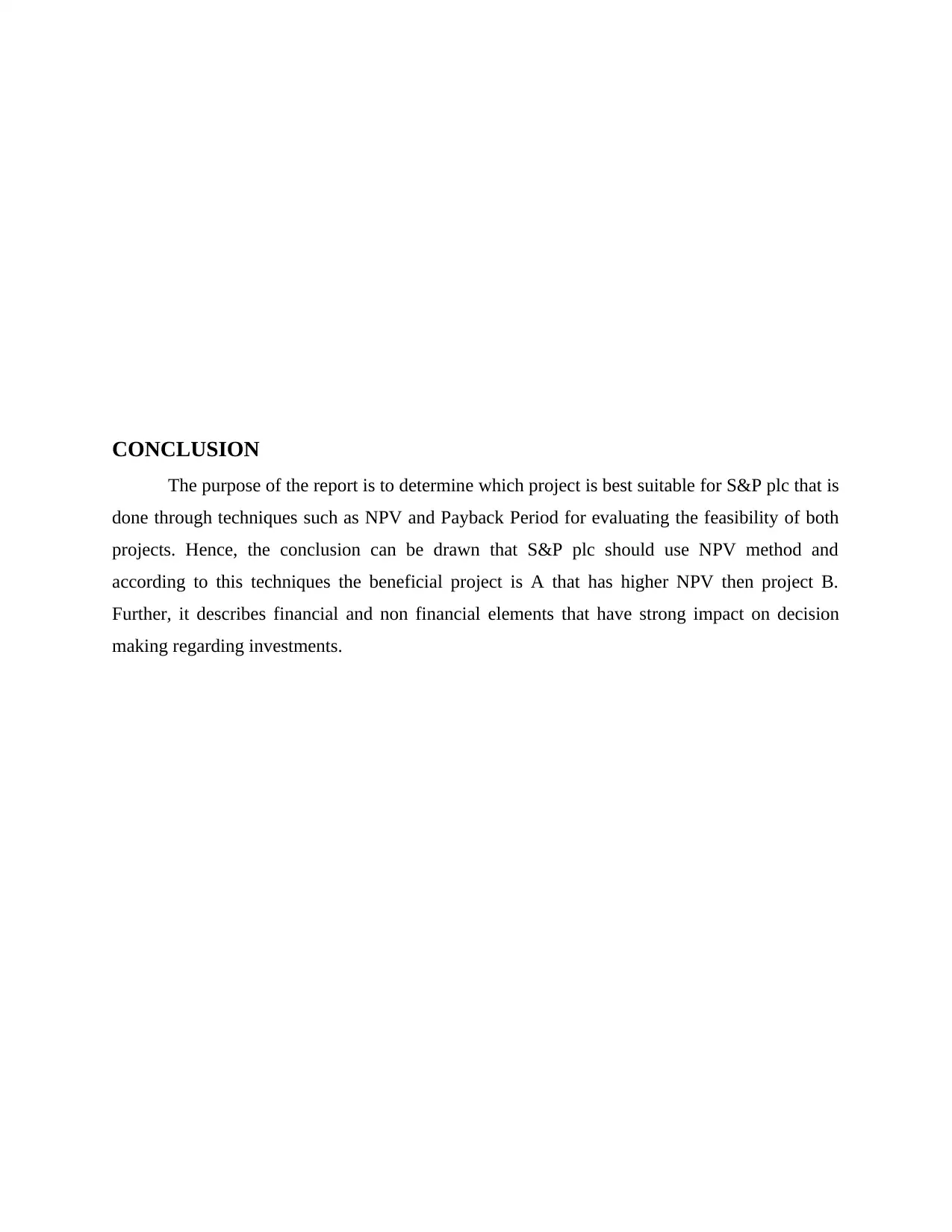
CONCLUSION
The purpose of the report is to determine which project is best suitable for S&P plc that is
done through techniques such as NPV and Payback Period for evaluating the feasibility of both
projects. Hence, the conclusion can be drawn that S&P plc should use NPV method and
according to this techniques the beneficial project is A that has higher NPV then project B.
Further, it describes financial and non financial elements that have strong impact on decision
making regarding investments.
The purpose of the report is to determine which project is best suitable for S&P plc that is
done through techniques such as NPV and Payback Period for evaluating the feasibility of both
projects. Hence, the conclusion can be drawn that S&P plc should use NPV method and
according to this techniques the beneficial project is A that has higher NPV then project B.
Further, it describes financial and non financial elements that have strong impact on decision
making regarding investments.
Paraphrase This Document
Need a fresh take? Get an instant paraphrase of this document with our AI Paraphraser

REFERENCES
Books and Journals
Black, K., 2019. Business statistics: for contemporary decision making. John Wiley & Sons.
Castle, E.N., Becker, M.H. and Smith, F.J., 2021. Farm business management: the decision
making process. Farm business management: the decision making process. Second
Edition.
Cyert, R.M., Dill, W.R. and March, J.G., 2020. The role of expectations in business decision
making. Administrative Science Quarterly, pp.307-340.
He, W., Wang, F.K. and Akula, V., 2018. Managing extracted knowledge from big social media
data for business decision making. Journal of Knowledge Management.
Mowen, M.M., Hansen, D.R. and Heitger, D.L., 2022. Managerial accounting: The cornerstone
of business decision-making. Cengage learning.
Books and Journals
Black, K., 2019. Business statistics: for contemporary decision making. John Wiley & Sons.
Castle, E.N., Becker, M.H. and Smith, F.J., 2021. Farm business management: the decision
making process. Farm business management: the decision making process. Second
Edition.
Cyert, R.M., Dill, W.R. and March, J.G., 2020. The role of expectations in business decision
making. Administrative Science Quarterly, pp.307-340.
He, W., Wang, F.K. and Akula, V., 2018. Managing extracted knowledge from big social media
data for business decision making. Journal of Knowledge Management.
Mowen, M.M., Hansen, D.R. and Heitger, D.L., 2022. Managerial accounting: The cornerstone
of business decision-making. Cengage learning.
1 out of 8
Related Documents
Your All-in-One AI-Powered Toolkit for Academic Success.
+13062052269
info@desklib.com
Available 24*7 on WhatsApp / Email
![[object Object]](/_next/static/media/star-bottom.7253800d.svg)
Unlock your academic potential
Copyright © 2020–2025 A2Z Services. All Rights Reserved. Developed and managed by ZUCOL.




